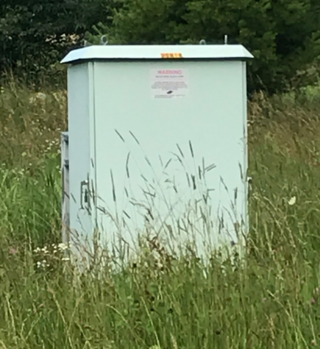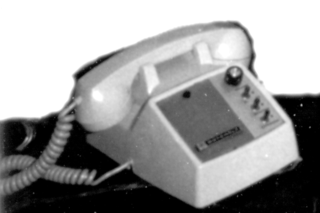
The 5ESS Switching System is a Class 5 telephone electronic switching system developed by Western Electric for the American Telephone and Telegraph Company (AT&T) and the Bell System in the United States. It came into service in 1982 and the last unit was produced in 2003.
Distributed switching is an architecture in which multiple processor-controlled switching units are distributed. There is often a hierarchy of switching elements, with a centralized host switch and with remote switches located close to concentrations of users.

In modern telephony a remote concentrator, remote concentrator unit (RCU), or remote line concentrator (RLC) is a concentrator at the lowest level in the telephone switch hierarchy.

An emergency telephone number is a number that allows a caller to contact local emergency services for assistance. The emergency number differs from country to country; it is typically a three-digit number so that it can be easily remembered and dialed quickly. Some countries have a different emergency number for each of the different emergency services; these often differ only by the last digit.

A blue box is an electronic device that produces tones used to generate the in-band signaling tones formerly used within the North American long-distance telephone network to send line status and called number information over voice circuits. This allowed an illicit user, referred to as a "phreaker", to place long-distance calls, without using the network's user facilities, that would be billed to another number or dismissed entirely as an incomplete call. A number of similar "color boxes" were also created to control other aspects of the phone network.

Base station is – according to the International Telecommunication Union's (ITU) Radio Regulations (RR) – a "land station in the land mobile service."
A telephone numbering plan is a type of numbering scheme used in telecommunication to assign telephone numbers to subscriber telephones or other telephony endpoints. Telephone numbers are the addresses of participants in a telephone network, reachable by a system of destination code routing. Telephone numbering plans are defined in each of the administrative regions of the public switched telephone network (PSTN) and in private telephone networks.
CLLI code is a Common Language Information Services identifier used within the North American telecommunications industry to specify the location and function of telecommunications equipment or of a relevant location such as an international border or a supporting equipment location, like a manhole or pole. Originally, they were used by Bell Telephone companies, but since all other telecommunications carriers needed to interconnect with the dominant Bell companies, CLLI code adoption eventually became universal. CLLI codes are now maintained and issued by iconectiv, which claims trademarks on the names "Common Language" and "CLLI".

In analog telephony, a telephone hybrid is the component at the ends of a subscriber line of the public switched telephone network (PSTN) that converts between two-wire and four-wire forms of bidirectional audio paths. When used in broadcast facilities to enable the airing of telephone callers, the broadcast-quality telephone hybrid is known as a broadcast telephone hybrid or telephone balance unit.
System X is the digital switching system installed in almost all telephone exchanges throughout the United Kingdom, from 1980 onwards.
In telecommunications networks, a node is either a redistribution point or a communication endpoint.

A business telephone system is a telephone system typically used in business environments, encompassing the range of technology from the key telephone system (KTS) to the private branch exchange (PBX).

The DMS-100 is a member of the Digital Multiplex System (DMS) product line of telephone exchange switches manufactured by Northern Telecom. Designed during the 1970s and released in 1979, it can control 100,000 telephone lines.

An intercom, also called an intercommunication device, intercommunicator, or interphone, is a stand-alone voice communications system for use within a building, small collection of buildings or portably within a small coverage area, which functions independently of the public telephone network. Intercoms are generally mounted permanently in buildings and vehicles, but can also be detachable and portable. Intercoms can incorporate connections to public address loudspeaker systems, walkie talkies, telephones, and other intercom systems. Some intercom systems incorporate control of devices such as signal lights and door latches.

A subscriber loop carrier or subscriber line carrier (SLC) provides telephone exchange-like telephone interface functionality. SLC remote terminals are typically located in areas with a high density of telephone subscribers, such as a residential neighborhood, or very rural areas with widely dispersed customers, that are remote from the telephone company's central office (CO). Two or four T1 circuits connect the SLC remote terminal to the central office terminal (COT), in the case of a universal subscriber loop carrier (USLC). An integrated subscriber loop carrier (ISLC) has its T-spans terminating directly in time division switching equipment in the telephone exchange.
The GTD-5 EAX is the Class 5 telephone switch developed by GTE Automatic Electric Laboratories. This digital central office telephone circuit switching system is used in the former GTE service areas and by many smaller telecommunications service providers.

Remote controls are used any time a two-way radio base station is located away from the desk or office where communication originates. For example, a dispatch center for taxicabs may have an office downtown but have a base station on a distant mountain top. A Tone remote, also known as an EIA Tone remote, is a signaling system used to operate a two-way radio base station by some form of remote control.
Historically, a foreign exchange service (FX) was an access service in a telecommunications network in which a telephone in a given exchange area is connected, via a private line, as opposed to a switched line, to a telephone exchange or central office in another exchange area, called the foreign exchange, rather than the local exchange area where the subscriber station equipment is located. To call originators, it appears that the called party having the FX service is located in the foreign exchange area. It is assigned a telephone number of the foreign exchange. The telecommunication circuit between central offices that implements foreign exchange service has complementary interface types at each end. At the foreign central office that provides the service, the interface is called the foreign exchange office (FXO) end, and at the end where the subscriber station is connected, it provides the foreign exchange station (FXS) interface.
The original North American area codes were established by the American Telephone and Telegraph Company (AT&T) in 1947, after the demonstration of regional Operator Toll Dialing during the World War II period. The program had the goal of speeding the connecting times for long-distance calling by eliminating intermediary telephone operators. Expanding this technology for national use required a comprehensive and universal, continent-wide telephone numbering plan.

A telephone exchange, also known as a telephone switch or central office, is a crucial component in the public switched telephone network (PSTN) or large enterprise telecommunications systems. It facilitates the interconnection of telephone subscriber lines or digital system virtual circuits, enabling telephone calls between subscribers.











